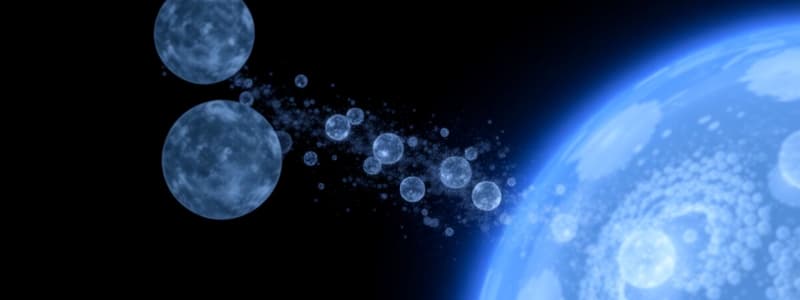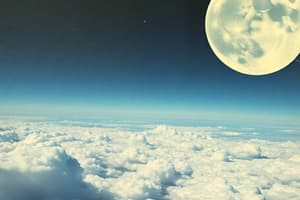Podcast
Questions and Answers
What does the chemical symbol 'O' represent?
What does the chemical symbol 'O' represent?
- Ozone
- Oxygen (correct)
- Hydrogen
- Carbon
Which statement best describes ozone?
Which statement best describes ozone?
- It is a waste product of aquatic life.
- It is the most abundant gas in the atmosphere.
- It absorbs UV radiation. (correct)
- It contains only one type of atom.
What factor increases the production of free oxygen in the stratosphere?
What factor increases the production of free oxygen in the stratosphere?
- Greater solar radiance (correct)
- Presence of pollutants
- Low altitude
- High levels of carbon dioxide
How does temperature affect dissolved oxygen in water?
How does temperature affect dissolved oxygen in water?
What does the term Biological Oxygen Demand (BOD) refer to?
What does the term Biological Oxygen Demand (BOD) refer to?
Where is ozone concentration typically highest?
Where is ozone concentration typically highest?
What is a significant source of free oxygen in the polluted troposphere?
What is a significant source of free oxygen in the polluted troposphere?
Which of the following correctly describes the abundance of oxygen on Earth?
Which of the following correctly describes the abundance of oxygen on Earth?
Flashcards are hidden until you start studying
Study Notes
Oxygen
- Oxygen is a chemical element with the symbol O and atomic number 8.
- It is a colorless, odorless, and tasteless gas at room temperature.
- Oxygen is the third most abundant element in the universe.
- It makes up a significant percentage of Earth's composition.
Ozone
- Ozone is a minor component of Earth's atmosphere, with a concentration of 0.02 to 0.1 ppm by volume.
- It absorbs ultraviolet (UV) radiation.
- The ozone layer is important for protecting life on Earth from harmful UV radiation.
Chapman Reaction
- The Chapman reaction is a cycle of chemical reactions that explains the formation and destruction of ozone in the stratosphere.
Sources of Free Oxygen
- Stratosphere:
- UV photons below 242 nm break O₂ into free oxygen atoms (O).
- The rate of oxygen production depends on season, latitude, and altitude.
- Higher photochemical oxygen production occurs at the equator and high altitudes.
- Troposphere:
- UV radiation above 30 km depletes O₂.
- Ozone is produced at a rate similar to oxygen depletion.
- Photochemical dissociation of NO₂ is a key source of oxygen in polluted tropospheres.
Ozone Variation
- Ozone concentration increases with altitude.
- The ozone layer provides protection from harmful UV radiation.
Dissolved Oxygen
- Dissolved oxygen (DO) is the amount of oxygen dissolved in water.
- It is essential for aquatic life.
- DO is higher in rapidly moving bodies of water and lower in stagnant water.
Factors Affecting Dissolved Oxygen
- Temperature: DO is inversely proportional to water temperature.
- Organic matter decomposition: Consumes oxygen, leading to lower DO levels in eutrophic conditions.
- Photosynthesis: Produces oxygen in aquatic systems.
Biological Oxygen Demand (BOD)
- BOD is a measure of the oxygen used by microorganisms to decompose waste.
Studying That Suits You
Use AI to generate personalized quizzes and flashcards to suit your learning preferences.




